LIBRE Project Blog
Back in September, we posted about the geographical distribution of LIBRE participants when we had about 450 surveys completed. Now that data collection has finished, it makes sense to post an updated version of this map! Seen below, the map represents the geographical layout of the final 601 LIBRE participants in the United States and Canada. Thank you to everyone for making sure voices from around the continent contributed to this work!
As you may have seen in our newsletter, we are excited to announce that we have officially decided to call our measure The LIBRE Profile. The LIBRE Profile will be available for administration as a Computerized Adaptive Test (CAT) and through Short Forms, which can be filled out with pencil and paper. We decided on this name because the scores obtained from answering questions in each of the social reintegration domains (Relationships with Family and Friends, Social Interactions, Social Activities, Work and Employment, Romantic Relationships, and Sexual Relationships) will provide a profile of the burn survivor during his or her rehabilitation process. It is not simply a score, but instead a way to capture a more holistic representation of a burn survivor’s social recovery after the injury.
With a new name, we need an updated logo and we are hoping you can help us decide! Please see above the possible logo options and email us to tell us your favorite! Refer to the images above and write: top left, top right, bottom left or bottom right to indicate your choice. With your help, we’ll decide on the final option by the end of the month. Thank you in advance!
Have you ever answered a health questionnaire and realized that half of the questions didn’t have anything to do with you? We don’t want you wasting your time - we’re all busy and every extra free minute can mean a lot. A Computerized Adaptive Test (CAT) is an approach to patient-reported assessment that takes your time into consideration. A CAT uses state-of-the-art technology to assess each individual, providing a precise score by selecting questions that are tailored to each participant. With the CAT approach, a person is not required to respond to irrelevant questions. To introduce how a CAT works, we developed a new infographic seen below:
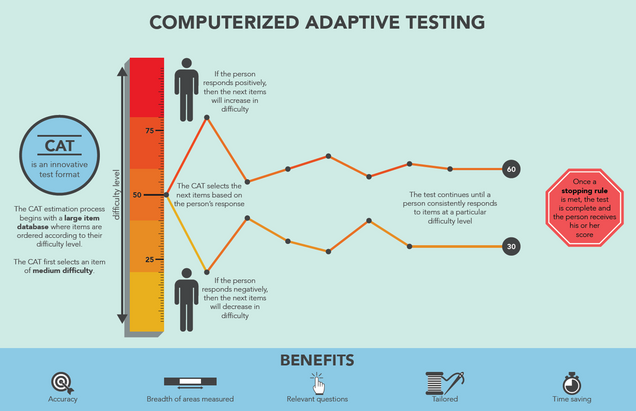
CATs are based on a large group of questions that are organized based on difficulty and how much information a question gives for a particular population. Each person begins by answering a question in the mid-range level of difficulty, and then the CAT will select the next question with a different difficulty level based on the individual’s response. For example, a mid-range question about a person’s ability to move around would be “On a scale of 1 to 5, with 1 being not difficult at all to 5 being extremely difficult, how difficult is it to walk up a hill?” If a person answers 1, she will be asked an easier question, such as “How difficult is it to walk for one block without stopping?” If she answers 5 to the first question, she would be asked a more difficult question, such as “How difficult is it to jog for 2 miles?”
In the infographic, grey dots indicate the point at which a question is asked, and the line denotes whether the next question selected by the CAT is easier or more difficult. This pattern of selecting questions continues until either the CAT has asked a maximum number of questions, or the score estimate has reached a specified level of precision. Using a CAT approach, a precise score is estimated with only a few well-selected questions.
The LIBRE Profile uses CAT technology to measure the social reintegration after a burn injury. We want to be able to pinpoint areas in a burn survivor’s social life that might need more attention and more resources. LIBRE measures six domains of social reintegration: Relationships with Family & Friends, Social Interactions, Social Activities, Work & Employment, Romantic Relationships, and Sexual Relationships. The burn survivor responds to questions within each of these domains (if applicable), and is provided scores in each appropriate domain at the end. Scores are compared to other people in similar situations and to a non-burned population. These comparisons make it easier to figure out where more help is needed and where the burn survivor is doing particularly well.
If you’re a faithful LIBRE Facebook follower you may have noticed we were quite busy last week. Members of our staff and Clinical Advisory Board attended the American Burn Association (ABA) annual meeting in Las Vegas, May 3-May 6. The ABA is a national organization dedicated to improving the lives of everyone affected by burn injury. Its members support burn-related research, education, care, rehabilitation and prevention. We attended the conference last year to recruit participants for our study and also support our team members in presentations.
This year, our focus was on presentations of the preliminary findings from LIBRE data collection. We had submitted 10 abstracts to the ABA and all were accepted as either a poster, presentation or plenary presentation. Please see below for the full list. It was a pleasure to attend the conference, and an honor to represent all the hard work that has gone into the LIBRE Project so far!
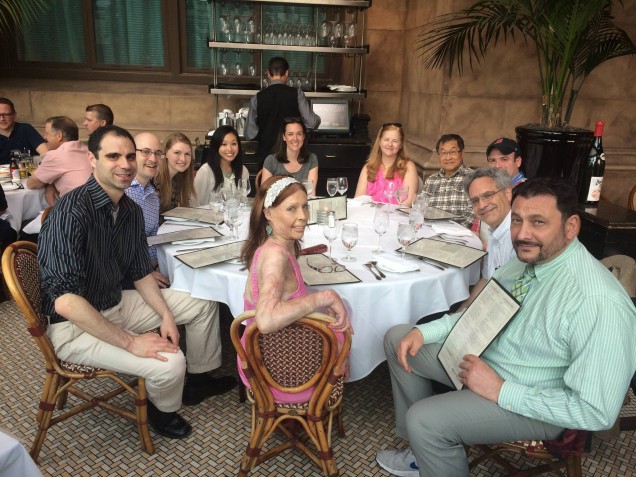
Dinner on the first night in Las Vegas.
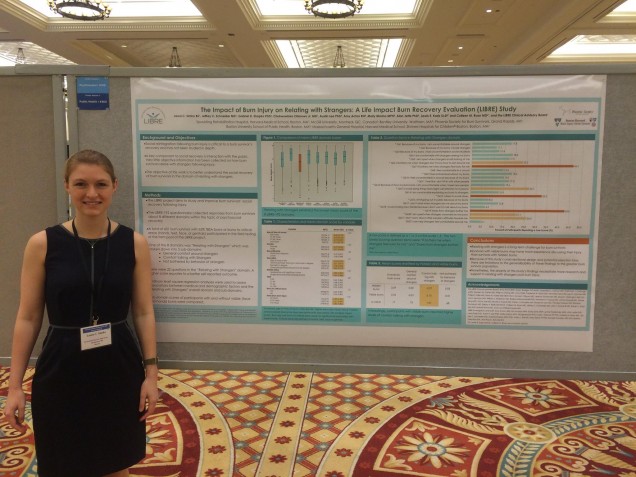
Laura C. Simko, BS presented: The Impact of Burn Injury on Relating with Strangers: A Life Impact Burn Recovery Evaluation (LIBRE) Study as a poster. It won the Best in Category award!
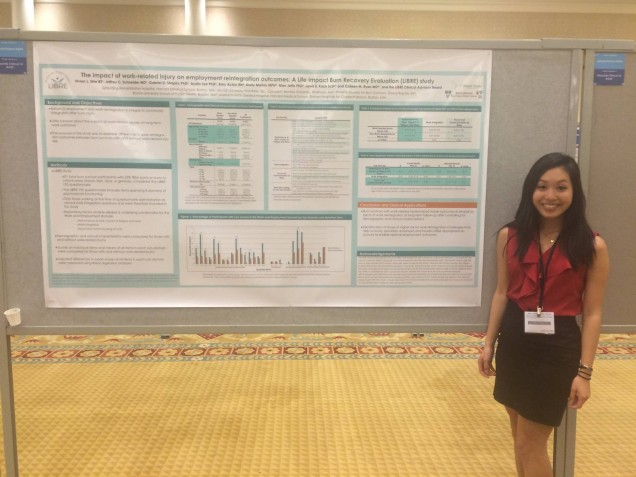
Vivian Shie, BS presented: The Impact of Work-Related Injury on Employment Reintegration Outcomes: A Life Impact Burn Recovery Evaluation (LIBRE) Study as a poster.
Colleen M. Ryan, MD presented: The Effects of Burn Size on Long-Term Community Reintegration Outcomes: A Life Impact Burn Recovery Evaluation (LIBRE) Study as the plenary presentation.
Gabriel Shapiro, PhD presented: Factor Structure of the Life Impact Burn Recovery Evaluation Questionnaire (LIBRE – 192) as a poster.
Jeremy Goverman, MD presented: Psychosocial Outcomes 10 Years Post-Burn: A Life Impact Burn Recovery Evaluation (LIBRE) Study as an oral presentation.
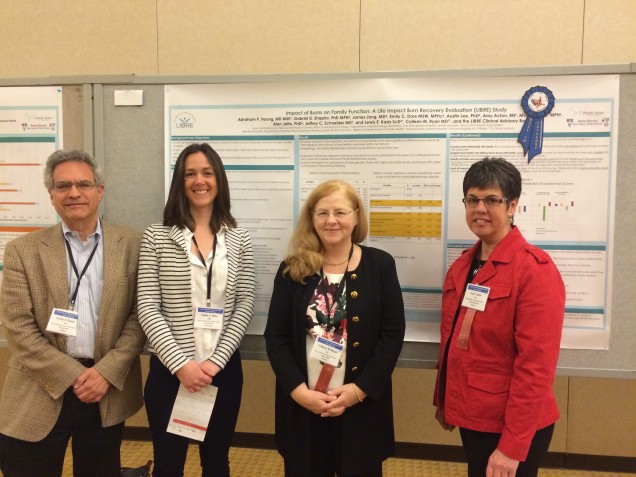
Emily Dore, MSW presented: Impact of Burns on Family Function: A Life Impact Burn Recovery Evaluation (LIBRE) Study as a poster. It won the Best in Category award!
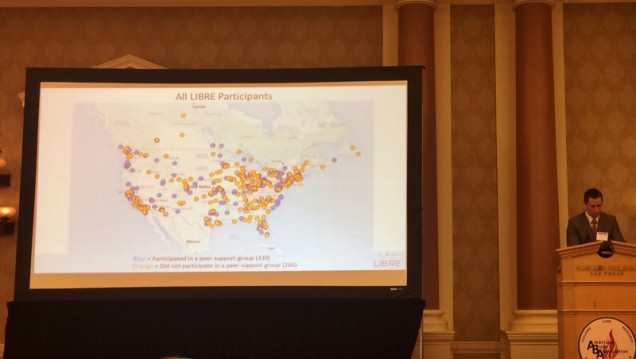
Brian Grieve, BA presented: Assessment of the Role of Peer Support Groups in psychosocial recovery from burn injury: A Life Impact Burn Recovery Evaluation (LIBRE) Study as an oral presentation.
Benjamin Levi, MD presented: The Impact of Gender on Long-Term Community Reintegration Following Burn Injury: A Life Impact Burn Recovery Evaluation (LIBRE) Study as an oral presentation.
Sara Cartwright, MD presented: Burn Survivors Injured as Children Exhibit Resilience in Long-Term Community Integration Outcomes: A Life Impact Burn Recovery Evaluation (LIBRE) Study as a poster.
John T. Schulz III, MD presented The Impact of Education on Quality of Burn Survival: A Life Impact Burn Recovery Evaluation (LIBRE) Study as a poster.
With the help and feedback of the burn survivor community, our film intern, Alicia Winton, and the Phoenix Society, we created a short video that is designed as a public service announcement (PSA) for burn survivors and the general public. The PSA titled, "Don't know how to react to burn survivors? #JustSmile," demonstrates some of the difficulties encountered by burn survivors and provides a simple approach to creating a more positive and accepting environment. We hope to have this PSA shared widely on social media. Please watch and consider sharing.
Visit our website to add your name to our newsletter list, send us an email or visit our Facebook page to view a copy of your own. We share lots of exciting accomplishments including a new PSA, a talk from Phoenix Society's World Burn Congress 2015, and the completion of phase 1 of our project.
The newest issue of Phoenix Society's Burn Support Magazine features an article about LIBRE. Written by Melinda Rossi and Michael Saunders, the article uses words from burn survivors themselves to describe their experiences. It also discusses how the LIBRE Project's goal is to address and measure these experiences to aid in the recovery process. Read the whole magazine here, or turn to page 16 to read the article.
It’s our last day in the office until January 2016! Hard to believe. We had such a great year here at LIBRE and we feel so fortunate to end on such a high note. As many of you know, we reached our goal of 600 completed surveys on December 11, 2015. Think about that for a second. 600 individual burn survivors filled out our questionnaire within 14 months! We couldn’t have done it without all of our partners and of course, the burn survivor community. Thank you, thank you, thank you.
Looking back on 2015, we made trips to the ABA conference in Chicago, ISOQOL in Berlin, and the World Burn Congress in Indianapolis. We submitted manuscripts based on the project, attended burn survivor support groups, worked with BU student groups to create educational materials, and built our clinical advisory board. All along, we met amazing, inspiring people that have helped make the project what it is today.
When we get back in 2016, we’ll start to build the Computer Adaptive Test (CAT) prototype based on the survey responses we received. We have other projects in the works that will support the eventual goal of our project. Our January 2016 newsletter will come out with lots more information so make sure to sign up now if you haven’t yet!
Happy Holidays and Happy New Year!
We’ve been back in the office for a week now and we’re finally feeling caught up after the Phoenix World Burn Congress (WBC) in Indianapolis. We were so successful in administering surveys, that we had lots of paperwork to sort through, data to enter, and people to call! WBC was just as inspiring and fun as last year, and we feel lucky to be able to be a part of this community. Last year we went to kick off Phase 2 of our project, and this year we’re just starting the process of closing it. We’ll be collecting survey responses through December 20, 2015, or once we have 600 completed surveys, whichever comes first. So if you’ve been considering taking the survey but haven’t yet – there is now limited time to do so.
Forty-one burn survivors completed the survey at WBC, and several have finished the survey since. On October 21st, when we left for WBC, we had 464 completed surveys and we now have a total of 525 completed surveys! This puts us right on track for 600 by the end of December if we’re able to keep up this pace. Also, we have opened up eligibility requirements so that we are accepting all burn survivors, 18 years or older, no matter how long ago they sustained their burn injury. Call us at 844-255-9987 or email us at libre@bu.edu to learn more.
Now for your viewing pleasure, some pictures from our trip to Indianapolis! Check out more on our Facebook page, including a video that came out better than the blurry jumping picture below :)
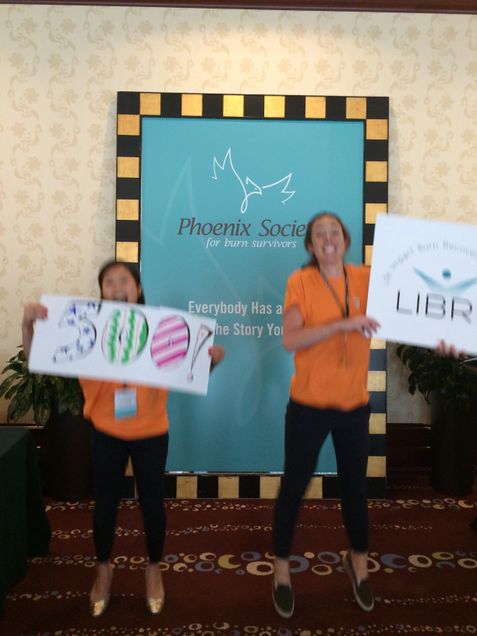
Check us out – this map shows where the LIBRE study participants are coming from – a strong showing from California, the Midwest and the Northeast especially! It’s exciting to see everyone is pretty spread out and representing a good amount of the United States. We’re currently strategizing how to boost our Canadian contingency, so hopefully we’ll see a few more dots there soon. We’d also love to have more participants from states like Alaska, Delaware, Mississippi and West Virginia. Join the group and help us expand our reach by learning more about our survey. Or, we’ll be at the World Burn Congress in Indianapolis at the end of October – come see us then!